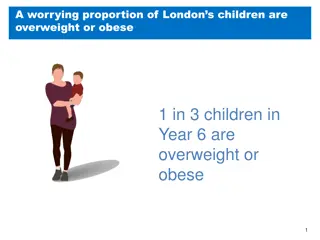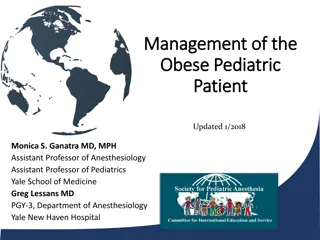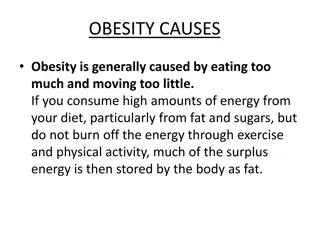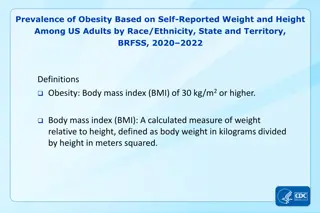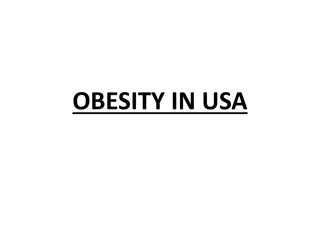Obesity
Obesity, its causes, and how it affects overall health. Discover the role of factors such as genetics, lifestyle, and eating habits. Explore the prevalence of obesity worldwide and its correlation with various diseases. Understand the measurement of obesity through BMI and its different categories.
Download Presentation

Please find below an Image/Link to download the presentation.
The content on the website is provided AS IS for your information and personal use only. It may not be sold, licensed, or shared on other websites without obtaining consent from the author. Download presentation by click this link. If you encounter any issues during the download, it is possible that the publisher has removed the file from their server.
E N D
Presentation Transcript
BPT 3RDYEAR STUDENT ROLL NO-32
What is obesity Obesity is define as an abnormal growth of the adipose tissue due to an enlargement of fat cell size (hypertropicobesity) or an increased in fat cell number(hyperplastic obesity) or a combination of both. People are classified as obese when their body mass index (BMI) Obesity is correlated with various diseases and conditions, particularlycardiovascular diseases, type 2 diabetes, certain types of cancer, and osteoarthritis
Epidemiology determinants age sex genetic factor physical inactivity eating habits Alcohol and smoking endocrine factors
Epidemiology The worldwide prevalence of obesity nearly tripled between 1975 and 2016 In 2016, more than 1.9billion adults, 18 years and older, were overweight. Of those over 650 million were obese. Overall, about 13% of the world adult population (11% of men and 15% of women) were obese in 2016 The prevalence of overweight and obesity among children and adolescent aged 5-19 has risen dramatically from 4% in 1975 to 18% in 2016
Measurement of obesity BMI(Body mass index) The BMI is defined as the body massdivided by the squareof the body height, and is expressed in unitsof kg/m2
BMI(kg/m2) category Underweight(severe thinness) < 16.0 . Underweight 16.0 16.9 Underweight 17.0 18.4 normal 18.5 24.9 overweight 25.0 29.9 Obese (class1) 30.0 34.9 Obese (class2) 35.0 39.9
Inactivity obesity Lack of physical activity can cause you to become overweight. In this type of obesity, once
Food obesity If you overeat, and particularly if you overindulge in unhealthy foods, you may suffer from food obesity. Excessive sugar intake can also cause food density, lead to accumulation of fat around the middle part of body
Atherogenic obesity People whose fat tends to accumulate in the stomach area often suffer from atherogenic obesity It can affect organs and lead to breathing problems. Extremely important to avoid drinking alcohol if you have atherogenicobestiy
Anxiety obesity Anxiety can often lead to overreacting and accumulation of fat in the body To treat this type of obesity, you must control your anxiety Common treatments include medication, a decrease in caffeine intake
Venous obesity Venous obesity is more of a genetic in nature, rather than habitual in nature. This type of obesity is particularly common in pregnancy Exercise is the best solution for this problem
Gluten obesity You are likely no stranger to many health problem that gluten can cause. In fact, gluten generally cause obesity This type of weight gain is most common in women It is often spotted during periods of hormonal change, like puberty, pregnancy, and menopause.
Factors responsible for obesity Behavioral and lifestyle factors Mental illness genetics
Behavioral and lifestyle factors Unhealthy dietary patterns(carbohydrates increase blood glucose level results in weight gain) Less physical inactivity Medication use(high blood pressure medication) Easy availability of fast-food Food marketing and promotion
Diseases cushing s disease Polycystic ovary syndrome Thyriod and other endocrine disorders Mental illness Depression Eating disorders Genetics A person is more likely to develop obesity if one or both parents are obese Genetics also affect hormones involved in fat regulation For example one genetic cause of obesity is leptin deficiency
Health consequences of obesity According to Centers for Disease Control and Prevention obesity affects all organ system and create following health effects. Hypertension Type 2 diabetes Coronary heart diseases Stroke Low quality of life Mental illness osteoarthritis
Primary prevention Assess BMI at least annually, monitor for increasing BMI. Review dietary and physical activity habits in addition to sleep duration Review other obesity risk factors such as medication use, family history and lack of nutritional knowledge Encourage a self-management approach including setting goals for healthy lifestyle habits Physical activity and exercise









